Shinkansen
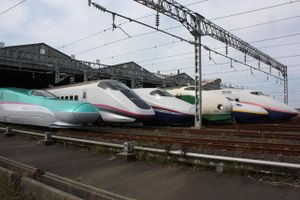

The Shinkansen (新幹線, new main line), also known as the bullet train, is a network of high-speed railway lines in Japan operated by four Japan Railways Group companies. Starting with the 210 km/h (130 mph) Tōkaidō Shinkansen in 1964, the now 2,459 km (1,528 mi) long network has expanded to link most major cities on the islands of Honshū and Kyūshū at speeds up to 300 km/h (186 mph). Test runs have reached 443 km/h (275 mph) for conventional rail in 1996, and up to a world record 581 km/h (361 mph) for maglev trainsets in 2003.
Shinkansen literally means new trunk line, referring to the tracks, but the name is widely used inside and outside Japan to refer to the trains as well as the system as a whole. The name Superexpress (超特急 chō-tokkyū), initially used for Hikari trains, was retired in 1972 but is still used in English-language announcements and signage.
The Tōkaidō Shinkansen is the world's busiest high-speed rail line. Carrying 151 million passengers a year (March 2008),[1] it has transported more passengers (over 6 billion)[2] than any other high speed line in the world.[3] Between Tokyo and Osaka, the two largest metropolises in Japan, up to ten trains per hour with 16 cars each (1,300 seats capacity) run in each direction with a minimum of 3 minutes between trains. Though largely a long-distance transport system, the Shinkansen also serves commuters who travel to work in metropolitan areas from outlying cities.
Contents |
Technology
To enable high-speed operation, Shinkansen uses advanced technologies compared with conventional rail, and it achieved not only high speed but also a high standard of safety and comfort. Its success has influenced other railways in the world and the importance and advantage of high-speed rail has consequently been revalued.
Routing
- Shinkansen routes are completely separate from conventional rail lines (except Mini-shinkansen which goes through to conventional lines). Consequently, Shinkansen is not affected by slower local or freight trains and has the capacity to operate many high-speed trains punctually.
- It uses tunnels and viaducts to go through and over obstacles rather than around them, with a minimum curve radius of 4,000 meters (2,500 meters on the oldest Tōkaidō Shinkansen).
- The Shinkansen system is built without road crossings at grade.
- Tracks are strictly off-limits with penalties against trespassing strictly regulated by law.
Track
- The Shinkansen uses 1,435 mm standard gauge in contrast to the 1,067 mm narrow gauge of older lines.
- Continuous welded rail is exclusively used.
- Swingnose crossing are employed, eliminating gaps at turnouts and crossings.
- Long rails are used, joined by expansion joints to minimize gauge fluctuation due to thermal elongation and shrinkage.
- A combination of ballasted and slab track are used, with slab track exclusively employed on concrete bed sections such as viaducts and tunnels. Slab track is significantly more cost-effective in tunnel sections, since the lower track height reduces the cross-sectional area of the tunnel, thereby reducing construction costs by up to 30%.[4]
Signal system
- It employs an ATC (Automatic Train Control) system, eliminating the need for trackside signals.
- Centralized traffic control manages all trains operation, and all tasks relating Shinkansen train, track, station and schedule are highly systemized by computer.
Electricity
Shinkansen uses a 25,000 V AC overhead power supply (20,000 V AC on Mini-shinkansen lines).
Trains
- Shinkansen trains are electric multiple unit style, offering high acceleration and deceleration, and reduced damage to the track because of lighter vehicles.
- Shinkansen cars are air-sealed to ensure stable air pressure when entering tunnels at high speed.
Punctuality
The Shinkansen is very reliable, and in 2003, JR Central reported that the Shinkansen's average arrival time was within six seconds of the scheduled time. This includes all natural and human accidents and errors and is calculated over roughly 160,000 Shinkansen trips completed.[5] The previous record, from 1997, was 18 seconds.
Traction
The Shinkansen has used the electric multiple unit configuration from the outset, with the 0 Series Shinkansen having 100% motored axles. Other railway manufacturers have traditionally been reluctant to use distributed traction configurations: - Talgo has persisted with the locomotive configuration with the AVE Class 102 and plans to persist with it for the Talgo AVRIL on account of the fact that it is not possible to motor bogies used as part of the Talgo Pendular system. On the other hand, significant engineering desirability exists for the electric multiple unit configuration in Japan. A greater proportion of motored axles results in higher acceleration, meaning that the Shinkansen does not lose so much time if stopping frequently: - Shinkansen lines have more stops in proportion to their lengths than high-speed lines elsewhere in the world.
History
Japan was the first country to build dedicated railway lines for high speed travel. Because of the mountainous terrain, the existing network consisted of 3 ft 6 in (1,067 mm) narrow gauge lines, which generally took indirect routes and could not be adapted to higher speeds. Consequently, Japan had a greater need for new high speed lines than countries where the existing standard gauge or broad gauge rail system had more upgrade potential.
Early proposals
The popular English name bullet train is a literal translation of the Japanese term dangan ressha (弾丸列車), a nickname given to the project while it was initially being discussed in the 1930s. The name stuck because of the original 0 Series Shinkansen's resemblance to a bullet and its high speed.
The Shinkansen name was first formally used in 1940 for a proposed standard gauge passenger and freight line between Tokyo and Shimonoseki that would have used steam and electric locomotives with a top speed of 200 km/h (120 mph). Over the next three years, the Ministry of Railways drew up more ambitious plans to extend the line to Beijing (through a tunnel to Korea) and even Singapore, and build connections to the Trans-Siberian Railway and other trunk lines in Asia. These plans were abandoned in 1943 as Japan's position in World War II worsened. However, some construction did commence on the line; several tunnels on the present-day Shinkansen date to the war-era project.
Construction
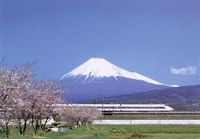
Following the end of World War II, high speed rail was forgotten for several years while traffic of passengers and freight steadily increased on the conventional Tōkaidō Main Line along with the reconstruction of Japanese industry and economy. By the mid-1950s the Tōkaidō Line was operating at full capacity, and the Ministry of Railways decided to revisit the Shinkansen project. In 1957, Odakyu Electric Railway introduced its Romancecar 3000 SE service, setting a world speed record of 145 km/h (90 mph) for a narrow gauge train. This train gave designers the confidence that they could safely build an even faster standard gauge train. Thus the first Shinkansen, the 0 Series, was built on the success of the Romancecar.
In 1950s, it was widely believed that railways would soon be outdated and replaced by air travel and highways as in America and many countries in Europe. However, Sogō Shinji, President of Japan National Railways, insisted strongly on the possibility of high-speed rail, and the Shinkansen project was implemented.
Government approval came in December 1958, and construction of the first segment of the Tōkaidō Shinkansen between Tokyo and Osaka started in April 1959. Some of the construction was financed by an US$80 million loan from the World Bank. A test facility for rolling stock, now part of the line, opened in Odawara in 1962.
Initial success
The Tōkaidō Shinkansen began service on 1 October 1964, in time for the Tokyo Olympics. The conventional Limited Express service took six hours and 40 minutes from Tokyo to Osaka, but the Shinkansen made the trip in just four hours, shortened to three hours and ten minutes by 1965. It enabled day trips between Tokyo and Osaka, the two largest metropolises in Japan, changed the style of business and life of Japanese people significantly, and increased new traffic demand. The service was an immediate success, reaching the 100 million passenger mark in less than three years on 13 July 1967, and one billion passengers in 1976. Sixteen-car trains were introduced for Expo '70 in Osaka. With an average of 23,000 passengers per hour per direction in 1992, the Tōkaidō Shinkansen is the world's busiest high-speed rail line.[6]
The first Shinkansen trains, the 0 series, ran at speeds of up to 210 km/h (130 mph), later increased to 220 km/h (137 mph). The last of these trains, with their classic bullet-nosed appearance, were retired on 30 November 2008. A driving car from one of the 0 series trains is now in the British National Railway Museum in York, England.
Network expansion
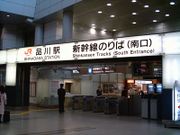
The Tōkaidō Line's rapid success prompted an extension westward to Hiroshima and Fukuoka (the Sanyō Shinkansen), which was completed in 1975.
Prime Minister Kakuei Tanaka was an ardent supporter of the Shinkansen, and his government proposed an extensive network paralleling most existing trunk lines. Two new lines, the Tōhoku Shinkansen and Jōetsu Shinkansen, were built following this plan. Many other planned lines were delayed or scrapped entirely as Japan National Railways slid into debt throughout the late '70s, largely because of the high cost of building the Shinkansen network. By the early 1980s, the company was practically insolvent, leading to its privatization in 1987.
Development of the Shinkansen continued despite this setback, however. Several new train models followed the first, each generally with its own distinctive appearance. Shinkansen trains now run regularly at speeds up to 300 km/h (186 mph), placing them alongside the French TGV, Italian TAV, Spanish AVE, and German ICE among the fastest trains in the world.
Since 1970, development has also been underway for the Chūō Shinkansen, a planned maglev line from Tokyo to Osaka. On 2 December 2003, the 3-car maglev trainset JR-Maglev MLX01 reached a world speed record of 581 km/h (361 mph).
Japan celebrated 40 years of high speed rail in 2004, with the Tōkaidō Shinkansen line alone having carried 4.16 billion passengers. According to Japanrail.com, the website for companies that operate Shinkansen, the network has carried over 6 billion passengers.
Safety record
During the Shinkansen's 45-year, nearly 7 billion-passenger history, there have been no passenger fatalities due to derailments or collisions, despite frequent earthquakes and typhoons. Injuries and a single fatality have been caused by doors closing on passengers or their belongings; attendants are employed at platforms to prevent such mishaps. There have, however, been suicides by passengers jumping both from and in front of moving trains.
The only derailment of a Shinkansen train in passenger service occurred during the Chūetsu Earthquake on 23 October 2004. Eight of ten cars of the Toki No. 325 train on the Jōetsu Shinkansen derailed near Nagaoka Station in Nagaoka, Niigata. There were no casualties among the 154 passengers.[7] In the event of an earthquake, an earthquake detection system can bring the train to a stop very quickly. A new anti-derailment device was installed after detailed analysis of the derailment.
Economics
The Shinkansen has had a great effect on Japan's business, economy, society, environment and culture.[6] The time savings alone from switching from a conventional to a high-speed network have been estimated at 400 million hours, an economic impact of ¥ 500 billion per year.[6] Shinkansen connectivity has rejuvenated rural towns such as Kakegawa that would otherwise be too distant from major cities.[6]
However, the vast construction costs of the Shinkansen network, particularly the later, less profitable lines often driven more by political interference than actual demand, imposed vast debt servicing costs on JNR that, by 1971, made JNR unprofitable even before depreciation.[8] JNR's Shinkansen-fueled debt eventually ballooned to ¥28 trillion and was an instrumental factor in the company's eventual privatization and breakup.[8] The privatized JRs eventually paid a total of only ¥9.2 trillion to acquire JNR's Shinkansen network.[6]
Environmental impact
Travelling Tokyo-Osaka by Shinkansen produces only around 16% of the carbon dioxide of the equivalent journey by car, a savings of 15,000 tons of CO2 per year.[6]
Challenges encountered
Noise pollution
Noise pollution concerns mean that increasing speed is becoming more difficult. In Japan, the population density is high and there have been severe protests against noise pollution of Shinkansen, and now the Shinkansen noise is regulated less than 70 dB in residential area.[9] Hence, improvement and reduction of pantograph, weight saving of cars, and construction of noise barriers and other measures have been implemented. Current research is primarily aimed at reducing operational noise, particularly the tunnel boom phenomenon caused when trains exit tunnels at high speed.
Earthquake
Because of the risk of earthquakes, Urgent Earthquake Detection and Alarm System (UrEDAS) (earthquake warning system) was introduced in 1992. It enables automatic braking of bullet trains in the case of large earthquakes.
Heavy snow
The Tōkaidō Shinkansen often experiences heavy snow around in the area around Maibara Station in winter. Trains have to reduce speed, which can disrupt the timetable. Sprinkler systems were later installed, but delays of 10 to 20 minutes still occur during snowy weather. Along the route of the Jōetsu Shinkansen, winter snow can be very heavy, with snow depths of two to three metres, so the line is equipped with stronger sprinklers and slab track, to mitigate the effects of deep snow.
Future

Speed-up
JR East has announced that the E5 Series of trains, capable of up to 320 km/h (199 mph), is to be introduced coinciding with the opening of the Tōhoku Shinkansen extension from Hachinohe to Shin-Aomori in early 2011. Extensive trials using the Fastech 360 test trains has shown that operation at 360 km/h (224 mph) is not currently feasible because of problems of noise pollution, overhead wire wear, and braking distances. This may indicate the limits to railed Shinkansen technology, and eventually maglev or another technology will need to replace it. Operation at speeds of up to 320 km/h between Utsunomiya and Shin-Aomori is expected to allow journey times of around 3 hours for trains from Tokyo to Shin-Aomori (a distance of approximately 675 km (419 mi)).
Line extension
The Kyūshū Shinkansen from Kagoshima to Yatsushiro opened in March 2004. Four more extensions are currently under construction: Hakata-Yatsushiro and Hachinohe-Aomori will open by the end of fiscal 2010, Nagano-Kanazawa by 2014, and Aomori-Hakodate (through the Seikan Tunnel) by 2015. There are also long-term plans to extend the network, including a new Hokkaidō Shinkansen from Hakodate to Sapporo, a branch of the Kyūshū Shinkansen to Nagasaki, and a link from Kanazawa back to Osaka, although none of these are likely to be completed by 2020.
The Narita Shinkansen project to connect Tokyo to Narita International Airport, initiated in the 1970s but halted in 1983 after landowner protests, has been officially cancelled and removed from the Basic Plan governing Shinkansen construction. Parts of its planned right-of-way were utilized by the Narita Sky Access Line when it opened in 2010. Although the Sky Access Line uses standard-gauge track, it was not built to Shinkansen specifications and there are no plans to convert it into a full Shinkansen line.
Maglev
The CEO of JR Central announced plans to have the maglev Chūō Shinkansen operating from Tokyo to Nagoya (366 km/227 mi) by 2025. Following the shortest route (through the Japanese Alps), JR Central estimates that it will take 40 minutes to run from Tokyo to Nagoya. However, Nagano Prefecture prefers a routing that swings north to serve the city of Chino and either Ina or Kiso-Fukushima. However, this will increase both the travel time (from Tokyo to Nagoya) and the cost of construction. Maglev trains have been doing test runs on the Yamanashi test tracks since 1997, running at speeds of over 500 km/h. Because of this extensive testing, maglev technology is almost ready for public usage.
Gauge Change Train
Experiments are taking place with a Gauge Change Train to enable direct operation between standard-gauge Shinkansen and narrow-gauge conventional lines; this could be useful for the Kyūshū Shinkansen branch to Nagasaki and other conventional lines. Future implementation awaits practical operational tests.
List of Shinkansen lines
The main Shinkansen lines are:
| Line | Start | End | Length | Operator | Opened | Annual Passengers[10] |
|---|---|---|---|---|---|---|
| Tōkaidō Shinkansen | Tokyo | Shin-Osaka | 515.4 km | JR Central | 1964 | 151,320,000 |
| Sanyō Shinkansen | Shin-Osaka | Hakata | 553.7 km | JR West | 1972 | 63,432,000 |
| Tōhoku Shinkansen | Tokyo | Hachinohe | 593.1 km | JR East | 1982 | 84,833,000 |
| Jōetsu Shinkansen | Ōmiya | Niigata | 269.5 km | 1982 | 38,294,000 | |
| Nagano Shinkansen (Hokuriku Shinkansen) | Takasaki | Nagano | 117.4 km | 1997 | 10,135,000 | |
| Kyūshū Shinkansen Kagoshima Route | Shin-Yatsushiro | Kagoshima-Chūō | 126.8 km | JR Kyūshū | 2004 | 4,184,000 |
Two further lines, known as Mini-shinkansen, have also been constructed by upgrading existing sections of line:
- Yamagata Shinkansen (Fukushima – Shinjō)
- Akita Shinkansen (Morioka – Akita)
There are two standard-gauge lines not technically classified as Shinkansen lines but with Shinkansen services:
- Hakata Minami Line (Hakata – Hakata-Minami)
- Gala-Yuzawa Line – technically a branch of the Jōetsu Line – (Echigo-Yuzawa – Gala-Yuzawa)
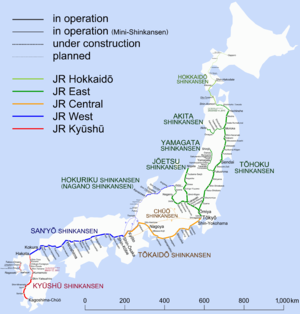 |
Map of Shinkansen lines except Hakata Minami Line and Gala-Yuzawa Line
|
Future lines
Many Shinkansen lines were proposed during the boom of the early 1970s but have yet to be constructed. These are called Seibi Shinkansen (整備新幹線) or planned Shinkansen. One of these lines, the Narita Shinkansen to Narita Airport, was officially cancelled, but a few remain under development.
- Tōhoku Shinkansen extension from Hachinohe Station to Shin-Aomori is under construction and will open by 2010.
- Hokuriku Shinkansen extension to Kanazawa is under construction and will open by 2014. Between Hakusan Depot near Kanazawa and Tsuruga, only Fukui Station is under construction. The complete extension of the line to Osaka is planned, but the route between Tsuruga and Shin-Ōsaka is not yet determined.
- Kyūshū Shinkansen section from Yatsushiro to Hakata is under construction and will open by 2011.
- Kyūshū Shinkansen branch from Shin-Tosu to Nagasaki, known as the Nagasaki Route (長崎ルート) or Nishi-Kyūshū Route (西九州ルート), started construction in 2008. The branch will, at least initially, be built as a narrow-gauge Super Tokkyū track that can be upgraded to full Shinkansen operation later.
- Hokkaidō Shinkansen from Shin-Aomori to Shin-Hakodate is under construction and will open by 2015. A further extension of the line from Shin-Hakodate to Sapporo is under development.
- Chuo Shinkansen (Tokyo-Nagoya-Osaka) is a planned maglev line. The Central Japan Railway Company has announced a 2025 target date, but aside from a short test section, construction has not started.
The following lines were also proposed in the 1973 plan, but have subsequently been shelved indefinitely.
- Hokkaidō South Loop Shinkansen (北海道南回り新幹線 Hokkaidō Minami-mawari Shinkansen): Oshamanbe - Muroran - Sapporo
- Uetsu Shinkansen (羽越新幹線): Toyama - Niigata - Akita
- Ōu Shinkansen (奥羽新幹線): Fukushima - Yamagata - Akita
- Hokuriku-Chūkyō Shinkansen (北陸・中京新幹線): Nagoya - Tsuruga
- Sanin Shinkansen (山陰新幹線): Osaka - Tottori - Matsue - Shimonoseki
- Trans-Chūgoku Shinkansen (中国横断新幹線 Chūgoku Ōdan Shinkansen): Okayama - Matsue
- Shikoku Shinkansen (四国新幹線): Osaka - Tokushima - Takamatsu - Matsuyama - Ōita
- Trans-Shikoku Shinkansen (四国横断新幹線 Shikoku Ōdan Shinkansen): Okayama - Kōchi - Matsuyama
- East Kyūshū Shinkansen (東九州新幹線 Higashi-Kyūshū Shinkansen): Fukuoka - Ōita - Miyazaki - Kagoshima
- Trans-Kyūshū Shinkansen (九州横断新幹線 Kyūshū Ōdan Shinkansen): Ōita - Kumamoto
In addition, the Basic Plan specified that the Jōetsu Shinkansen should start from Shinjuku, not Tokyo Station, which would require building an additional 30 km of track between Shinjuku and Ōmiya. While no construction work was ever started, land along the proposed track, including an underground section leading to Shinjuku Station, remains reserved. If capacity on the current Tokyo - Ōmiya section proves insufficient once the Hokkaidō and Hokuriku Shinkansen are operational, construction of the Shinjuku - Ōmiya link may be restarted.
In December 2009, transport minister Seiji Maehara proposed a bullet train link to Haneda Airport, using an existing spur that connects the Tōkaidō Shinkansen to a train depot. JR Central called the plan "unrealistic" due to tight train schedules on the existing line, but reports said that Maehara wished to continue discussions on the idea.[11]
Shinkansen technology outside Japan
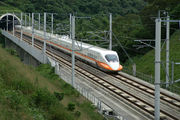

Railways using Shinkansen technology are not limited to those in Japan.
Taiwan
Taiwan High Speed Rail operates 700T Series sets built by Kawasaki Heavy Industries.
China
The China Railways CRH2 EMU, built by CSR Sifang Loco & Rolling stocks corporation, with the license purchased from a consortium formed of Kawasaki Heavy Industries, Mitsubishi Electric Corporation, and Hitachi, is based on the E2-1000 Series design.
United Kingdom
Class 395 EMUs were built by Hitachi based on Shinkansen technology for use on high-speed commuter services in Britain on the High Speed 1 line.
Brazil
Japan is currently promoting its Shinkansen technology to the Government of Brazil for use on the planned high speed rail link system set to link Rio de Janeiro, São Paulo and Campinas.[12] On 14 November 2008, Japanese Prime Minister Taro Aso and Brazilian President Luiz Inácio Lula da Silva talked about this rail project. President Lula asked a consortium of Japanese companies to participate in the bidding process. Prime Minister Aso concurred on the bilateral cooperation to improve rail infrastructure in Brazil, including the Rio-São Paulo-Campinas high-speed rail line.[13] The Japanese consortium includes the Ministry of Land, Infrastructure, Transport and Tourism, Mitsui & Co., Mitsubishi Heavy Industries, Kawasaki Heavy Industries and Toshiba.[14][15]
United States
- The U.S. Federal Railroad Administration is in talks with a number of countries with high speed rail, notably Japan, France and Spain. On 16 May 2009, FRA Deputy Chief Karen Rae expressed hope that Japan would offer its technical expertise to the United States. Transportation Secretary Ray LaHood indicated interest in test riding the Japanese Shinkansen in 2009.[16][17]
- On 1 June 2009, the Chairman of Central Japan Railway Company, Yoshiyuki Kasai, announced plans to export both the N-700 high speed train system and the JR-Maglev to international export markets, including the United States.[18]
Vietnam
Vietnam Railways will use Shinkansen technology for a high-speed rail link between the capital Hanoi and the southern commercial hub of Ho Chi Minh City, according to the Nihon Keizai Shimbun, citing an interview with Chief Executive Officer Nguyen Huu Bang. The Vietnamese government had already given basic approval for the Shinkansen system, although it still required financing and formal consent from the prime minister. Funding for the 56-billion-dollar project remained riddled with uncertainties, the report said, with Hanoi seeking Japanese Official Development Assistance and funds from the World Bank and Asian Development Bank. The 1,560-kilometre (970 mile) line would replace the current colonial-era rail line. Vietnam hopes to launch the high-speed trains by 2020 and plans to start by building three sections, including a 90-kilometre stretch between the central coastal cities of Da Nang and Huế, seen as potentially most profitable. Vietnam Railways began dispatching engineers to Central Japan Railway Company for technical training.[19][20]
List of Shinkansen train models
Trains can be up to sixteen cars long. With each car measuring 25 m (82 ft) in length, the longest trains are 400 m (1/4 mile) end to end. Stations are similarly long to accommodate these trains. Some of Japan's high-speed maglev trains are considered Shinkansen,[21] while other slower maglev trains (such as Linimo maglev train line serving local community near the city of Nagoya in Aichi, Japan) are intended as alternatives to conventional urban Rapid transit systems.

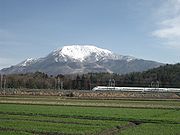
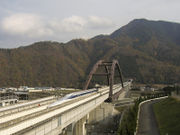
Passenger trains
Tōkaidō and Sanyō Shinkansen
- 0 series: The first Shinkansen trains, entering service in 1964, and withdrawn in 2008. Maximum operating speed was 220 km/h. More than 3,200 cars were built.
- 100 series: Entered service in 1985, and featured bilevel cars with restaurant car and compartments. Maximum operating speed is 230 km/h. Now used only on Sanyō Shinkansen Kodama services.
- 300 series: Entered service in 1992, initially on Nozomi services with maximum operating speed of 270 km/h.
- 500 series: Introduced on Nozomi services in 1997, with maximum operating speed is 300 km/h. Since 2008, some sets have been shortened from 16 to 8 cars for use on Sanyō Shinkansen Kodama services.
- 700 series: Introduced in 1999, with maximum operating speed of 285 km/h. Now widely used on Nozomi, Hikari, and Kodama services.
- N700 series: The most recently introduced type on the Tōkaidō and Sanyō Shinkansen, in service since 2007, with a maximum operating speed of 300 km/h.
Kyūshū Shinkansen
- 800 series: In service since 2004 on Tsubame services, with maximum speed 260 km/h.
Tōhoku, Jōetsu, and Nagano Shinkansen
- 200 series: The first type introduced on the Tōhoku, and Jōetsu Shinkansen in 1982. Maximum speed is 240 km/h. Some are still in operation as 10-car sets.
- E1 series: Bilevel 12-car trains in service since 1994 with maximum speed of 240 km/h.
- E2 series: In service since 1997 with maximum speed of 275 km/h.
- E4 series: Bilevel 8-car trains in service since 1997 with maximum speed of 240 km/h.
- E5 series (On order): Trains scheduled to enter service on Tōhoku Shinkansen in 2011 with a maximum speed of 320 km/h, becoming the fastest train in Japan.
Yamagata and Akita Shinkansen
- 400 series: The first Mini-shinkansen type, introduced in 1992 on Yamagata Shinkansen Tsubasa services. Withdrawn in April 2010.
- E3 series: Introduced in 1997 on Akita Shinkansen Komachi and Yamagata Shinkansen Tsubasa services.
- E6 series (On order): Scheduled to be introduced in 2013 Akita Shinkansen Komachi services, with maximum speed 320 km/h.
Taiwan High Speed Rail
- 700T series (Taiwan High Speed Rail, a.k.a. Taiwan Shinkansen): The first Shinkansen type exported outside Japan. 12-car trains based on 700 series entered service in 2007, with maximum speed of 300 km/h.
Experimental trains
- Class 1000
- Class 951
- Class 961
- Class 962
- 500-900 series "WIN350"
- Class 952/953 "STAR21"
- Class 955 "300X"
- Class E954 "Fastech 360S"
- Class E955 "Fastech 360Z"
Maglev trains
- LSM200 - 1972
- ML100 - 1972
- ML100A - 1975
- ML-500 - 1977
- ML-500R - 1979
- MLU001 - 1981
- MLU002 - 1987
- MLU002N - 1993
- MLX01 - 1996
- MLX01-901 - 2002
Maintenance vehicles
- 911 Type diesel locomotive
- 912 Type diesel locomotive
- DD18 Type diesel locomotive
- DD19 Type diesel locomotive
- 941 Type (rescue train)
- 921 Type (track inspection car)
- 922 Type (Doctor Yellow sets T1, T2, T3)
- 923 Type (Doctor Yellow sets T4, T5)
- 925 Type (Doctor Yellow sets S1, S2)
- E926 Type (East i)
List of types of Shinkansen services
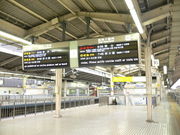
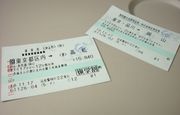
Originally intended to carry passenger and freight trains by day and night, the Shinkansen lines carry only passenger trains. The system shuts down between midnight and 06:00 every day for maintenance. The few overnight trains that still run in Japan run on the older narrow gauge network that the Shinkansen parallels.
Tōkaidō and Sanyō Shinkansen
- Nozomi (のぞみ)
- Hikari (ひかり)
- Hikari Rail Star (ひかりレールスター) (Shin-Osaka - Hakata only)
- Kodama (こだま)
Tōhoku, Yamagata and Akita Shinkansen
- Hayate (はやて)
- Yamabiko / Max Yamabiko (やまびこ)
- Nasuno / Max Nasuno (なすの)
- Aoba (あおば) (discontinued)
- Komachi (こまち) (Akita Shinkansen)
- Tsubasa (つばさ) (Yamagata Shinkansen)
Jōetsu Shinkansen
- Toki / Max Toki (とき)
- Tanigawa / Max Tanigawa (たにがわ)
- Asahi / Max Asahi (あさひ) (discontinued)
Hokuriku Shinkansen (Nagano Shinkansen)
- Asama / Max Asama (あさま)
Kyūshū Shinkansen
- Tsubame (つばめ)
- Sakura (さくら) (through service to Sanyō Shinkansen; from 12 March 2011)[22]
- Mizuho (みずほ) (limited-stop through service to Sanyō Shinkansen; from 12 March 2011)
Speed records
Source:[23]
| km/h (mph) | Train | Location | Date | Comments |
|---|---|---|---|---|
| 200 (124.3) | Class 1000 Shinkansen | Kamonomiya test track in Odawara, now part of Tōkaidō Shinkansen | 31 October 1962 | |
| 256 (159.1) | Class 1000 Shinkansen | Kamonomiya test track | 30 March 1963 | Former world speed record for EMU trains. |
| 286 (177.7) | Class 951 Shinkansen | Sanyō Shinkansen | 24 February 1972 | Former world speed record for EMU trains. |
| 319.0 (198.2) | Class 961 Shinkansen | Oyama test track, now part of Tōhoku Shinkansen | 7 December 1979 | Former world speed record for EMU trains. |
| 325.7 (202.4) | 300 series | Tōkaidō Shinkansen | 28 February 1991 | |
| 336.0 (208.8) | 400 series | Jōetsu Shinkansen | 26 March 1991 | |
| 345.0 (214.4) | 400 series | Jōetsu Shinkansen | 19 September 1991 | |
| 345.8 (214.9) | 500-900 series "WIN350" | Sanyō Shinkansen | 6 August 1992 | |
| 350.4 (217.7) | 500-900 series "WIN350" | Sanyō Shinkansen | 8 August 1992 | |
| 352.0 (218.7) | Class 952/953 "STAR21" | Jōetsu Shinkansen | 30 October 1992 | |
| 425.0 (264.1) | Class 952/953 "STAR21" | Jōetsu Shinkansen | 21 December 1993 | |
| 426.6 (265.1) | Class 955 "300X" | Tōkaidō Shinkansen | 11 July 1996 | |
| 443.0 (275.3) | Class 955 "300X" | Tōkaidō Shinkansen | 26 July 1996 |
Competition with air
Compared with air transport, the Shinkansen has several advantages, including scheduling frequency and flexibility, punctual operation, comfortable seats, and convenient city-center terminals.
The Shinkansen system and airlines often compete with each other for the business of city-to-city domestic travelers. If the Shinkansen connects two cities in less than three hours, most passengers choose the Shinkansen, but if it takes more than four hours by Shinkansen, the majority choose air. Some examples are as follows.
- Tokyo - Nagoya (342 km), Tokyo – Sendai (325 km), Tokyo – Hanamaki (Morioka) (496 km), Tokyo – Niigata (300 km): Once there was air service between these cities, but it was abolished after Shinkansen service started. Shinkansen runs between these cities in about two hours or less.
- Tokyo – Osaka (515 km): Shinkansen is dominant because of fast (2 hours and 30 minutes) and frequent service (up to every 10 minutes by Nozomi); however, air travel has a certain share (about 20 – 30 percent) because of the availability of discount fares.
- Tokyo – Okayama (676 km), Tokyo - Hiroshima (821 km): Shinkansen and air travel are mostly even in popularity. The Shinkansen takes about three to four hours and there are Nozomi trains every 30 minutes, but airlines may provide cheaper fares, attracting many passengers.
- Tokyo – Fukuoka (1,069 km): The Shinkansen takes about five hours even with the fastest Nozomi, and most people choose air. Fukuoka (Itatsuke) Airport is near to the CBD - Tenjin, and Fukuoka City Subway Line 1 connects the Airport and Tenjin, via Hakata Station.
- Osaka - Fukuoka (554 km): One of the most competitive sections. The Shinkansen takes about two and half hours by Nozomi, and JR West operates its own Hikari Rail Star trains twice an hour, taking about 2 hours and 40 minutes between the two cities.
See also
 Media related to Shinkansen at Wikimedia Commons
Media related to Shinkansen at Wikimedia Commons
Notes
- ↑ "JR Central Japan Website". http://english.jr-central.co.jp/company/company/achievement/transportation/index.html.
- ↑ Head, Jonathan (2004-10-01). "Japan marks bullet train's 40th". BBC News. http://news.bbc.co.uk/2/hi/asia-pacific/3707934.stm. Retrieved 2009-07-26.
- ↑ "Billions for high-speed rail". Associated Press. http://news.yahoo.com/s/ap_travel/20090326/ap_tr_ge/travel_brief_fast_trains. Retrieved 2009-07-26.
- ↑ Miura, S., Takai, H., Uchida, M., and Fukada, Y. The Mechanism of Railway Tracks. Japan Railway & Transport Review, 15, 38-45, 1998
- ↑ "Central Japan Railway Company Annual Report 2007" (PDF). p. 14. http://english.jr-central.co.jp/company/ir/annual-report/_pdf/report-2007.pdf. Retrieved 2008-06-24.
- ↑ 6.0 6.1 6.2 6.3 6.4 6.5 "Features and Economic and Social Effects of The Shinkansen". Jrtr.net. http://www.jrtr.net/jrtr03/f09_oka.html. Retrieved 2009-11-30.
- ↑ Report on Niigata Chuetsu EarthquakePDF (43.8 KB)
- ↑ 8.0 8.1 "Sensible Politics and Transport Theories?". Jrtr.net. http://www.jrtr.net/jrtr22/F23_Kakumoto.html. Retrieved 2009-11-30.
- ↑ "新幹線鉄道騒音に係る環境基準について(昭和50年環境庁告示) The Environmental Regulation of Shinkansen Noise Pollution (1975, Environmental Agency) (Japanese)". Env.go.jp. http://www.env.go.jp/kijun/oto3.html. Retrieved 2009-11-30.
- ↑ "鉄道輸送統計調査(平成19年度、国土交通省) Rail Transport Statistics (2007, Ministry of Land, Infrastructure and Transport) (Japanese)". Mlit.go.jp. http://www.mlit.go.jp/k-toukei/saisintoukei.html. Retrieved 2009-11-30.
- ↑ "Maehara sounds out JR Tokai over shinkansen link for Haneda airport". Japan Today. 28 December 2009. http://www.japantoday.com/category/national/view/maehara-sounds-out-jr-tokai-over-shinkansen-link-for-haneda-airport. Retrieved 28 December 2009.
- ↑ "ブラジルに新幹線導入を=日本政府・民間の動き活発化=大統領来日時に働きかけへ=新時代の友好協力の柱に". The Nikkey Shimbun. 2008-01-31. http://www.nikkeyshimbun.com.br/080131-71colonia.html. Retrieved 2009-06-02.(Japanese)
- ↑ "日ブラジル首脳会談(概要)". The Ministry of Foreign Affairs of Japan. 2008-11-14. http://www.mofa.go.jp/mofaj/kaidan/s_aso/fwe_08/jp_brazil.html. Retrieved 2009-06-02.(Japanese)
- ↑ "ブラジルに新幹線進出狙う 三井物産、建設に応札へ". Kyodo News. 2008-08-12. http://www.47news.jp/CN/200808/CN2008081201000767.html. Retrieved 2009-06-02.(Japanese)
- ↑ "ブラジルに新幹線売り込み】日本勢、高速鉄道建設で各国と競合". The Nikkei Net. 2009-06-17. http://www.nikkei.co.jp/news/sangyo/20090617AT1D1702A17062009.html. Retrieved 2009-07-12.(Japanese)
- ↑ "U.S. wants to study shinkansen technology". Kyodo News. 2009-05-16. http://search.japantimes.co.jp/cgi-bin/nn20090516a2.html. Retrieved 2009-06-02.
- ↑ "U.S. railroad official seeks Japan's help". United Press International. 2009-05-16. http://www.upi.com/Top_News/2009/05/16/US-railroad-official-seeks-Japans-help/UPI-84921242508429/. Retrieved 2009-06-02.
- ↑ "JR Tokai chief urges U.S. to introduce Japan's N700 bullet rail system". JapanToday. 2009-07-01. http://www.japantoday.com/category/business/view/jr-tokai-chief-urges-us-to-introduce-japans-n700-bullet-rail-system. Retrieved 2009-08-14.
- ↑ "ベトナム縦断で新幹線 国営鉄道会長、2020年部分開業目指す". The Nikkei Net. 2009-08-13. http://www.nikkei.co.jp/news/kaigai/20090813AT2M1203A12082009.html. Retrieved 2009-08-13.(Japanese)
- ↑ "Vietnam plans Japanese bullet train link". AFP. 2009-08-13. http://www.google.com/hostednews/afp/article/ALeqM5gv5p5C0gfrQ43JZcXx7lZ39KyfTg. Retrieved 2009-08-13.
- ↑ "FY2009 Key Measures and Capital Investment - Central Japan Railway Company". Central Japan Railway Company. 2009-03-27. http://english.jr-central.co.jp/news/n20090327/. Retrieved 2009-06-21.
- ↑ JR Kyushu: "新幹線の列車名決定!!" Retrieved on 26 February 2009 (Japanese)
- ↑ Semmens, Peter (1997). High Speed in Japan: Shinkansen - The World's Busiest High-speed Railway. Sheffield, UK: Platform 5 Publishing. ISBN 1-872524-88-5.
References
- Hood, Christopher P. (2006). Shinkansen – From Bullet Train to Symbol of Modern Japan. London: Routledge. ISBN 0-415-32052-6 (hb) or ISBN 0415444098. (pb)
External links
- Biting the Bullet: What we can learn from the Shinkansen, discussion paper by Christopher Hood in the electronic journal of contemporary japanese studies, 23 May 2001
- Encyclopaedia Britannica Shinkansen
- East meets West, a story of how the Shinkansen brought Tokyo and Osaka closer together.
- Bullet on wheels, a travel report by Vinod Jacob 19 Aug 2005
- Information on the N700 Shinkansen from railway-technology.com
|
|||||||||||||||||||||||||||||||||||||||||||||||||
|
||||||||||||||||||||||||||||||